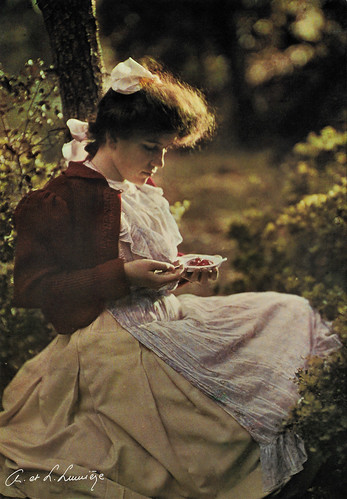
French postcard by Éditions AGEP, Marseille. Photo: Louis and Auguste Lumière, 1906.

French postcard by Éditions AGEP, Marseille. Photo: Louis and Auguste Lumière, 1906.
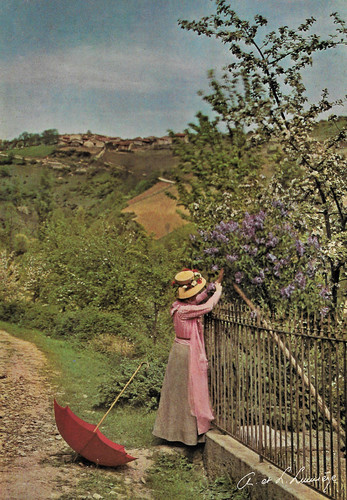
French postcard by Éditions AGEP, Marseille. Photo: Louis and Auguste Lumière, 1906.
News of the discovery spread quickly
When photography was first introduced, a sense of wonder was tempered by disappointment that colours could not be reliably captured. The search for a solution became photography’s ‘Holy Grail’. In 1903, Auguste and Louis Lumière in France patented the 'Autochrome Lumière' and presented their research into colour photography to the Académie des Sciences in 1904.
Three years later the Lumière brothers had perfected their process and began the commercial manufacture of autochrome plates at the Lumière factory in Lyon. The first public demonstration of the autochrome process took place on 10 June 1907, at the offices of the French newspaper L‘Illustration.
The event was a triumph. News of the discovery spread quickly and critical response was rapturous. Upon seeing his first autochrome, for example, the eminent photographer Alfred Stieglitz could scarcely contain his enthusiasm: "The possibilities of the process seem to be unlimited and soon the world will be colour-mad, and Lumière will be responsible."
Autochrome was an additive colour 'mosaic screen plate' process. It was the principal colour photography process in use before the advent of subtractive colour film in the mid-1930s. Prior to the Lumiere brothers, Louis Ducos du Hauron utilised the separation technique to create colour images on paper with screen plates, producing natural colours through superimposition, which would become the foundation of all commercial colour photography.
Descendants of photographer Antoine Lumiere, inventors Louis and Auguste Lumiere utilised Du Hauron's (1869) technique, which had already been improved upon by other inventors such as John Joly (1894) and James William McDonough (1896), making it possible to print photographic images in colour. One of the most broadly used forms of colour photography in the early twentieth century, autochrome was recognised for its aesthetic appeal.
Autochromes continued to be produced as glass plates into the 1930s when film-based versions were introduced, first Lumière Filmcolor sheet film in 1931, then Lumicolor roll film in 1933. Although these soon completely replaced glass plate Autochromes, their triumph was short-lived, as Kodak and Agfa soon began to produce multi-layer subtractive colour films (Kodachrome and Agfacolor Neu respectively).
Nevertheless, the Lumière products had a devoted following, above all in France, and their use persisted long after modern colour films had become available. The final version, Alticolor, was introduced in 1952 and discontinued in 1955, marking the end of the nearly fifty-year-long public life of the Autochrome.
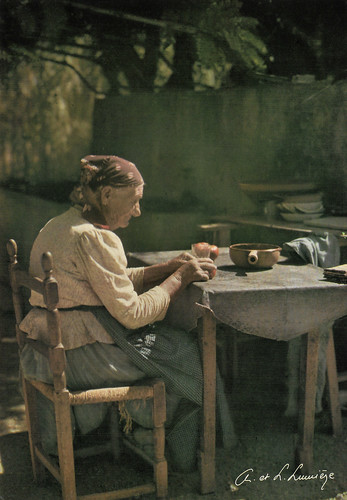
French postcard by Éditions AGEP, Marseille. Photo: Louis and Auguste Lumière, 1906.
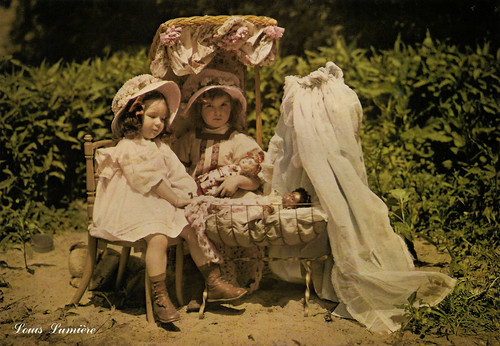
French postcard by Éditions AGEP, Marseille. Photo: Louis Lumière, 1906.
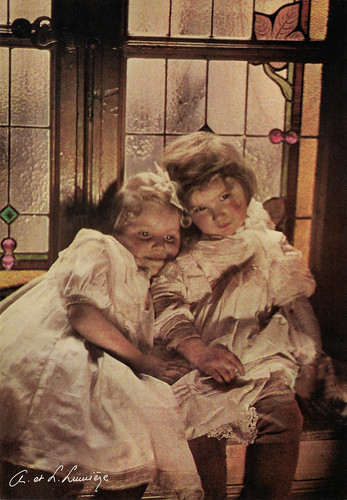
French postcard by Éditions AGEP, Marseille. Photo: Louis and Auguste Lumière, 1906.
Source: Science + Media Museum and Wikipedia.
I really enjoyed this post and there are some beautiful images here. Frankly I have often wondered about the early days of color photography---and now I know! I'll be linking back from my blog as we have some dedicated photography people in my neck of the woods.
ReplyDelete